University of Western Sydney Epidemiology Assignment 2, 2019
VerifiedAdded on 2022/12/01
|13
|2446
|293
Homework Assignment
AI Summary
This document presents a comprehensive solution to an epidemiology assignment, focusing on the analysis of case-control studies. The assignment delves into the study design of a national population-based case-control study examining the relationship between folic acid supplements and the risk of facial clefts, calculating and interpreting odds ratios, and discussing potential biases, including recall bias and confounding. The solution also addresses a second case-control study exploring the association between smoking, folic acid consumption, and cleft lip, calculating the odds ratio and interpreting the findings, and determining the potentially preventable proportion of cleft lip cases. Additionally, the assignment analyzes a study investigating the association between diabetes and atrial fibrillation, stratified by sex, employing chi-square tests to assess the association and exploring the concepts of confounding and attributable risk. Finally, the assignment addresses potential biases in a study of maternal hormone use during pregnancy and childhood cancer, identifying the type of bias introduced and explaining the concept of confounding.
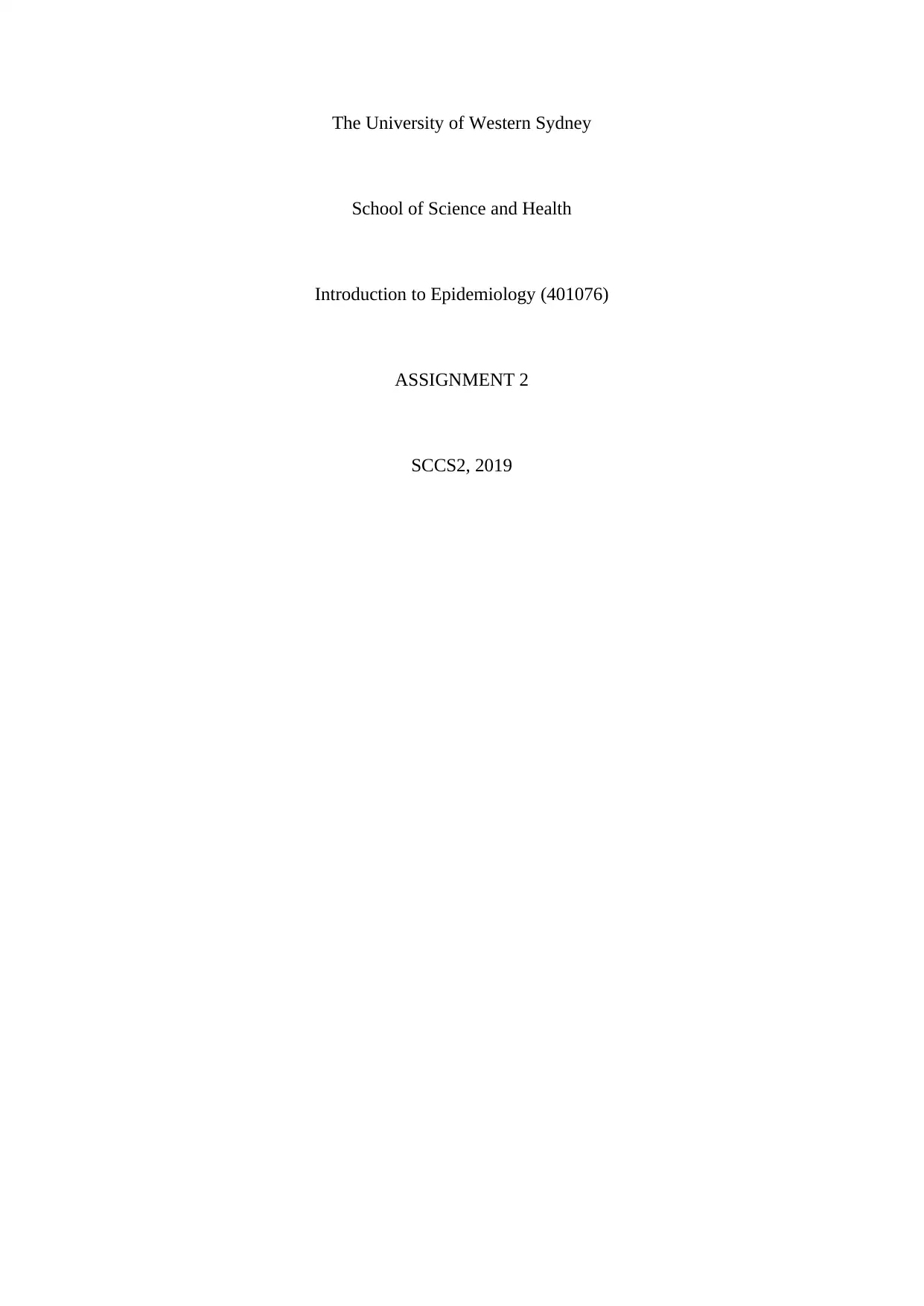
The University of Western Sydney
School of Science and Health
Introduction to Epidemiology (401076)
ASSIGNMENT 2
SCCS2, 2019
School of Science and Health
Introduction to Epidemiology (401076)
ASSIGNMENT 2
SCCS2, 2019
Paraphrase This Document
Need a fresh take? Get an instant paraphrase of this document with our AI Paraphraser
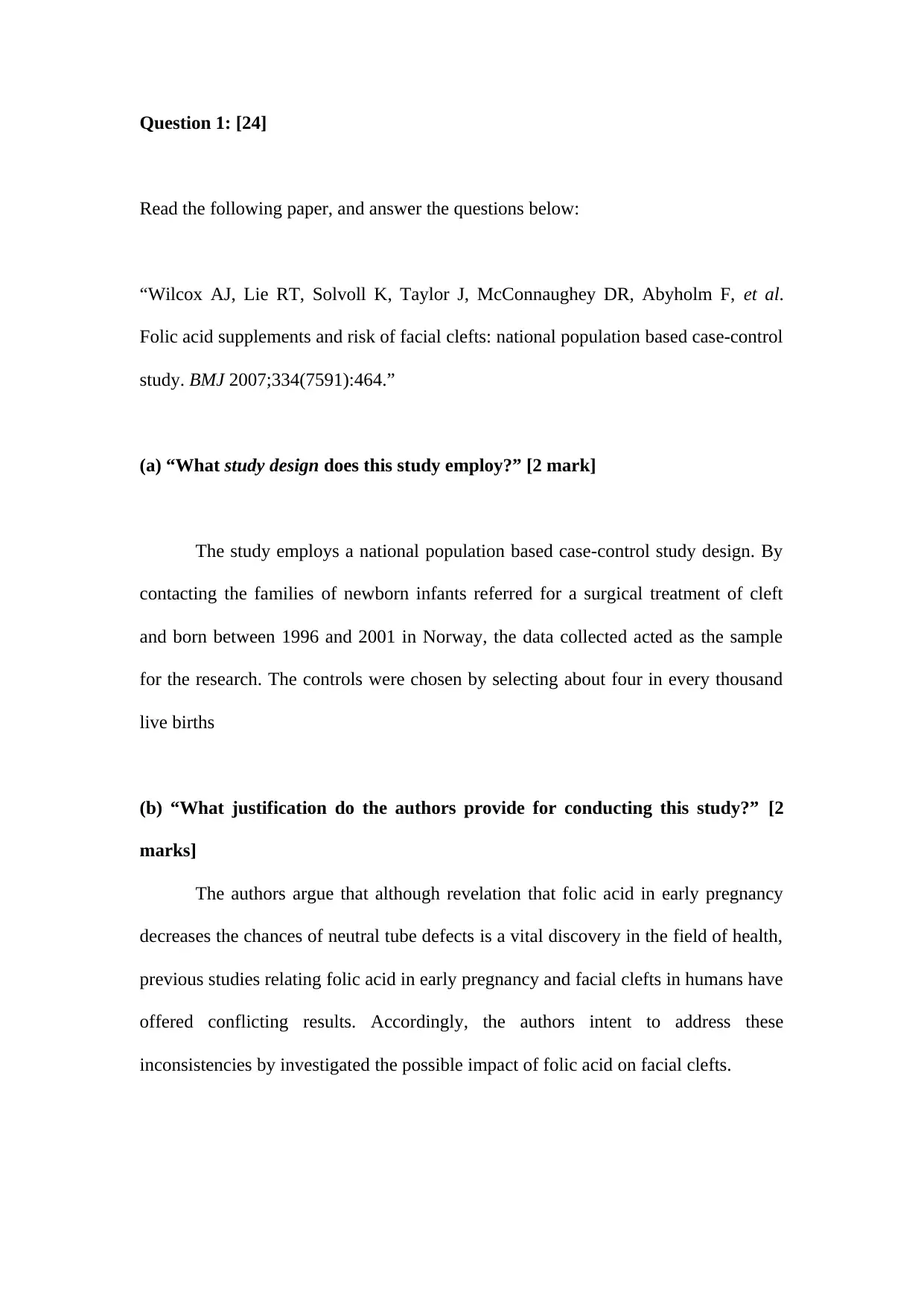
Question 1: [24]
Read the following paper, and answer the questions below:
“Wilcox AJ, Lie RT, Solvoll K, Taylor J, McConnaughey DR, Abyholm F, et al.
Folic acid supplements and risk of facial clefts: national population based case-control
study. BMJ 2007;334(7591):464.”
(a) “What study design does this study employ?” [2 mark]
The study employs a national population based case-control study design. By
contacting the families of newborn infants referred for a surgical treatment of cleft
and born between 1996 and 2001 in Norway, the data collected acted as the sample
for the research. The controls were chosen by selecting about four in every thousand
live births
(b) “What justification do the authors provide for conducting this study?” [2
marks]
The authors argue that although revelation that folic acid in early pregnancy
decreases the chances of neutral tube defects is a vital discovery in the field of health,
previous studies relating folic acid in early pregnancy and facial clefts in humans have
offered conflicting results. Accordingly, the authors intent to address these
inconsistencies by investigated the possible impact of folic acid on facial clefts.
Read the following paper, and answer the questions below:
“Wilcox AJ, Lie RT, Solvoll K, Taylor J, McConnaughey DR, Abyholm F, et al.
Folic acid supplements and risk of facial clefts: national population based case-control
study. BMJ 2007;334(7591):464.”
(a) “What study design does this study employ?” [2 mark]
The study employs a national population based case-control study design. By
contacting the families of newborn infants referred for a surgical treatment of cleft
and born between 1996 and 2001 in Norway, the data collected acted as the sample
for the research. The controls were chosen by selecting about four in every thousand
live births
(b) “What justification do the authors provide for conducting this study?” [2
marks]
The authors argue that although revelation that folic acid in early pregnancy
decreases the chances of neutral tube defects is a vital discovery in the field of health,
previous studies relating folic acid in early pregnancy and facial clefts in humans have
offered conflicting results. Accordingly, the authors intent to address these
inconsistencies by investigated the possible impact of folic acid on facial clefts.
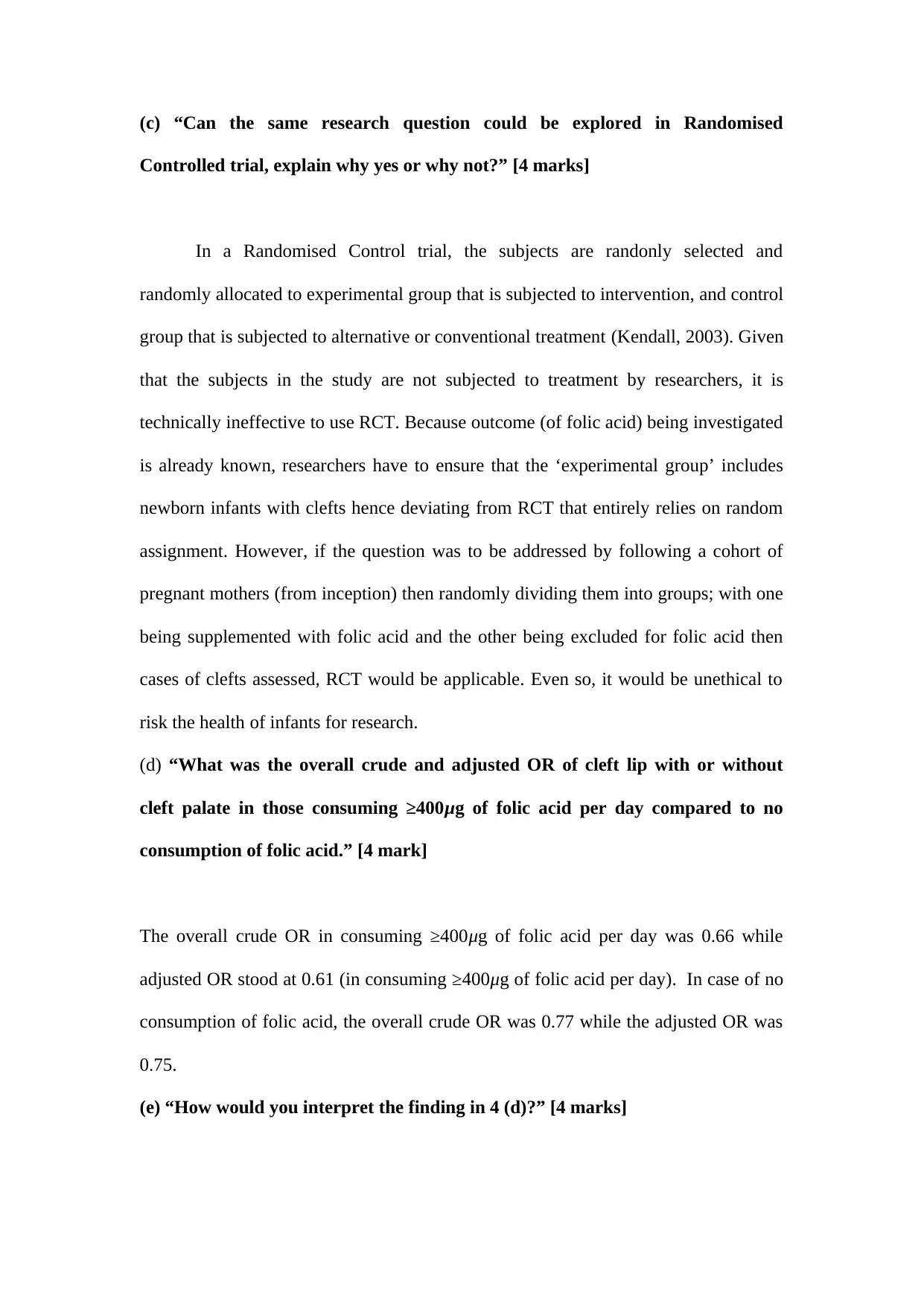
(c) “Can the same research question could be explored in Randomised
Controlled trial, explain why yes or why not?” [4 marks]
In a Randomised Control trial, the subjects are randonly selected and
randomly allocated to experimental group that is subjected to intervention, and control
group that is subjected to alternative or conventional treatment (Kendall, 2003). Given
that the subjects in the study are not subjected to treatment by researchers, it is
technically ineffective to use RCT. Because outcome (of folic acid) being investigated
is already known, researchers have to ensure that the ‘experimental group’ includes
newborn infants with clefts hence deviating from RCT that entirely relies on random
assignment. However, if the question was to be addressed by following a cohort of
pregnant mothers (from inception) then randomly dividing them into groups; with one
being supplemented with folic acid and the other being excluded for folic acid then
cases of clefts assessed, RCT would be applicable. Even so, it would be unethical to
risk the health of infants for research.
(d) “What was the overall crude and adjusted OR of cleft lip with or without
cleft palate in those consuming ≥400μg of folic acid per day compared to no
consumption of folic acid.” [4 mark]
The overall crude OR in consuming ≥400μg of folic acid per day was 0.66 while
adjusted OR stood at 0.61 (in consuming ≥400μg of folic acid per day). In case of no
consumption of folic acid, the overall crude OR was 0.77 while the adjusted OR was
0.75.
(e) “How would you interpret the finding in 4 (d)?” [4 marks]
Controlled trial, explain why yes or why not?” [4 marks]
In a Randomised Control trial, the subjects are randonly selected and
randomly allocated to experimental group that is subjected to intervention, and control
group that is subjected to alternative or conventional treatment (Kendall, 2003). Given
that the subjects in the study are not subjected to treatment by researchers, it is
technically ineffective to use RCT. Because outcome (of folic acid) being investigated
is already known, researchers have to ensure that the ‘experimental group’ includes
newborn infants with clefts hence deviating from RCT that entirely relies on random
assignment. However, if the question was to be addressed by following a cohort of
pregnant mothers (from inception) then randomly dividing them into groups; with one
being supplemented with folic acid and the other being excluded for folic acid then
cases of clefts assessed, RCT would be applicable. Even so, it would be unethical to
risk the health of infants for research.
(d) “What was the overall crude and adjusted OR of cleft lip with or without
cleft palate in those consuming ≥400μg of folic acid per day compared to no
consumption of folic acid.” [4 mark]
The overall crude OR in consuming ≥400μg of folic acid per day was 0.66 while
adjusted OR stood at 0.61 (in consuming ≥400μg of folic acid per day). In case of no
consumption of folic acid, the overall crude OR was 0.77 while the adjusted OR was
0.75.
(e) “How would you interpret the finding in 4 (d)?” [4 marks]
⊘ This is a preview!⊘
Do you want full access?
Subscribe today to unlock all pages.

Trusted by 1+ million students worldwide
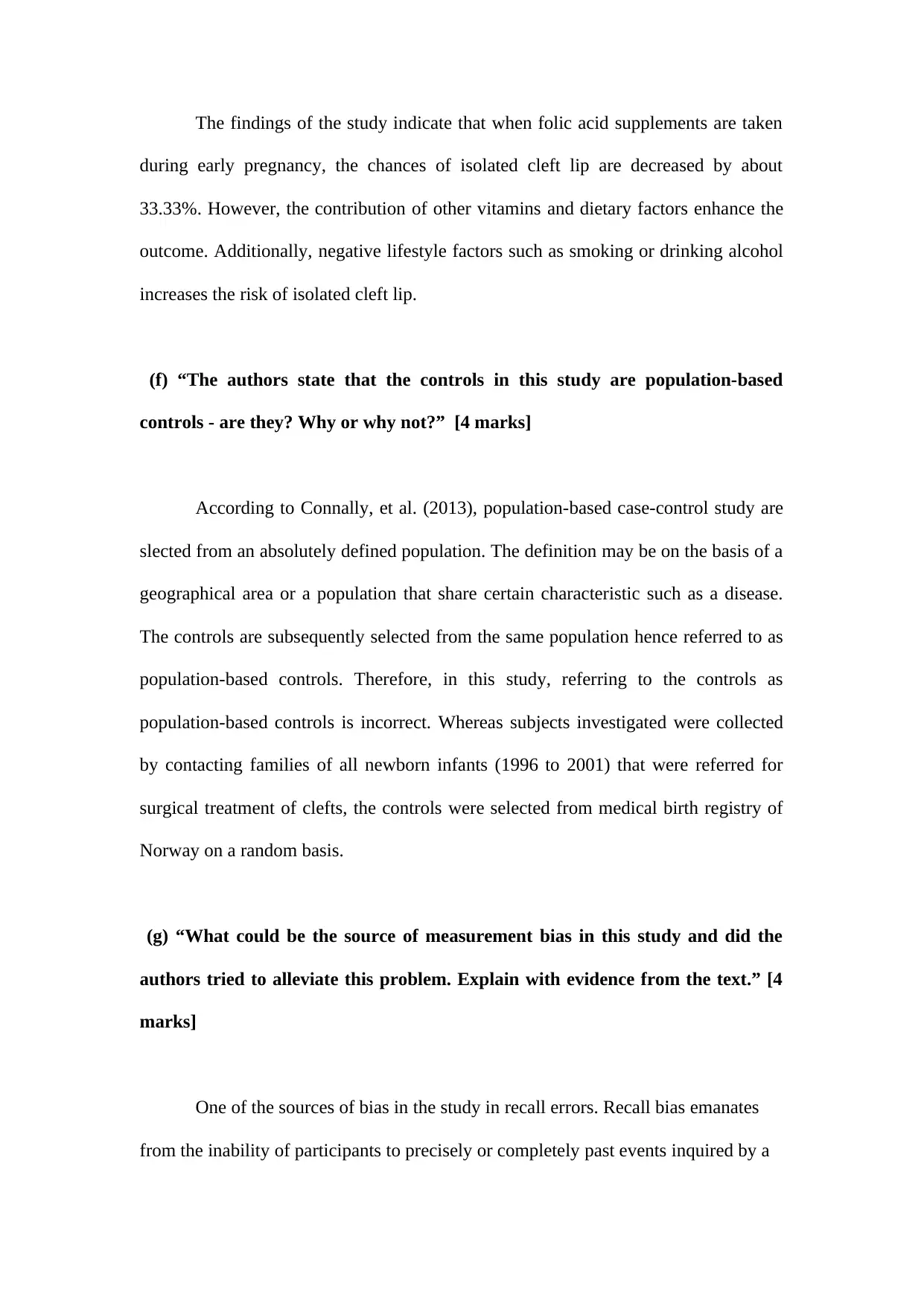
The findings of the study indicate that when folic acid supplements are taken
during early pregnancy, the chances of isolated cleft lip are decreased by about
33.33%. However, the contribution of other vitamins and dietary factors enhance the
outcome. Additionally, negative lifestyle factors such as smoking or drinking alcohol
increases the risk of isolated cleft lip.
(f) “The authors state that the controls in this study are population-based
controls - are they? Why or why not?” [4 marks]
According to Connally, et al. (2013), population-based case-control study are
slected from an absolutely defined population. The definition may be on the basis of a
geographical area or a population that share certain characteristic such as a disease.
The controls are subsequently selected from the same population hence referred to as
population-based controls. Therefore, in this study, referring to the controls as
population-based controls is incorrect. Whereas subjects investigated were collected
by contacting families of all newborn infants (1996 to 2001) that were referred for
surgical treatment of clefts, the controls were selected from medical birth registry of
Norway on a random basis.
(g) “What could be the source of measurement bias in this study and did the
authors tried to alleviate this problem. Explain with evidence from the text.” [4
marks]
One of the sources of bias in the study in recall errors. Recall bias emanates
from the inability of participants to precisely or completely past events inquired by a
during early pregnancy, the chances of isolated cleft lip are decreased by about
33.33%. However, the contribution of other vitamins and dietary factors enhance the
outcome. Additionally, negative lifestyle factors such as smoking or drinking alcohol
increases the risk of isolated cleft lip.
(f) “The authors state that the controls in this study are population-based
controls - are they? Why or why not?” [4 marks]
According to Connally, et al. (2013), population-based case-control study are
slected from an absolutely defined population. The definition may be on the basis of a
geographical area or a population that share certain characteristic such as a disease.
The controls are subsequently selected from the same population hence referred to as
population-based controls. Therefore, in this study, referring to the controls as
population-based controls is incorrect. Whereas subjects investigated were collected
by contacting families of all newborn infants (1996 to 2001) that were referred for
surgical treatment of clefts, the controls were selected from medical birth registry of
Norway on a random basis.
(g) “What could be the source of measurement bias in this study and did the
authors tried to alleviate this problem. Explain with evidence from the text.” [4
marks]
One of the sources of bias in the study in recall errors. Recall bias emanates
from the inability of participants to precisely or completely past events inquired by a
Paraphrase This Document
Need a fresh take? Get an instant paraphrase of this document with our AI Paraphraser
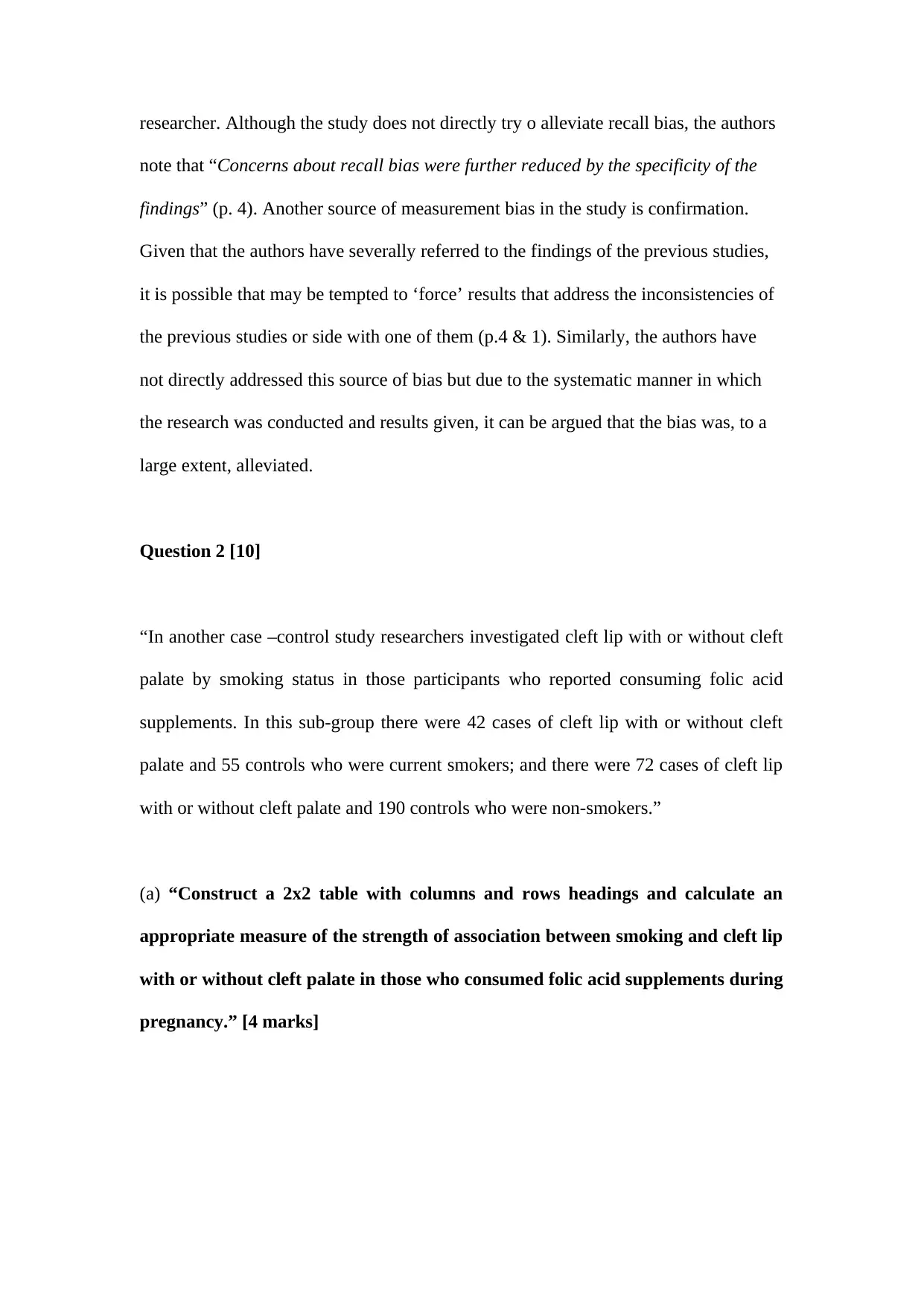
researcher. Although the study does not directly try o alleviate recall bias, the authors
note that “Concerns about recall bias were further reduced by the specificity of the
findings” (p. 4). Another source of measurement bias in the study is confirmation.
Given that the authors have severally referred to the findings of the previous studies,
it is possible that may be tempted to ‘force’ results that address the inconsistencies of
the previous studies or side with one of them (p.4 & 1). Similarly, the authors have
not directly addressed this source of bias but due to the systematic manner in which
the research was conducted and results given, it can be argued that the bias was, to a
large extent, alleviated.
Question 2 [10]
“In another case –control study researchers investigated cleft lip with or without cleft
palate by smoking status in those participants who reported consuming folic acid
supplements. In this sub-group there were 42 cases of cleft lip with or without cleft
palate and 55 controls who were current smokers; and there were 72 cases of cleft lip
with or without cleft palate and 190 controls who were non-smokers.”
(a) “Construct a 2x2 table with columns and rows headings and calculate an
appropriate measure of the strength of association between smoking and cleft lip
with or without cleft palate in those who consumed folic acid supplements during
pregnancy.” [4 marks]
note that “Concerns about recall bias were further reduced by the specificity of the
findings” (p. 4). Another source of measurement bias in the study is confirmation.
Given that the authors have severally referred to the findings of the previous studies,
it is possible that may be tempted to ‘force’ results that address the inconsistencies of
the previous studies or side with one of them (p.4 & 1). Similarly, the authors have
not directly addressed this source of bias but due to the systematic manner in which
the research was conducted and results given, it can be argued that the bias was, to a
large extent, alleviated.
Question 2 [10]
“In another case –control study researchers investigated cleft lip with or without cleft
palate by smoking status in those participants who reported consuming folic acid
supplements. In this sub-group there were 42 cases of cleft lip with or without cleft
palate and 55 controls who were current smokers; and there were 72 cases of cleft lip
with or without cleft palate and 190 controls who were non-smokers.”
(a) “Construct a 2x2 table with columns and rows headings and calculate an
appropriate measure of the strength of association between smoking and cleft lip
with or without cleft palate in those who consumed folic acid supplements during
pregnancy.” [4 marks]
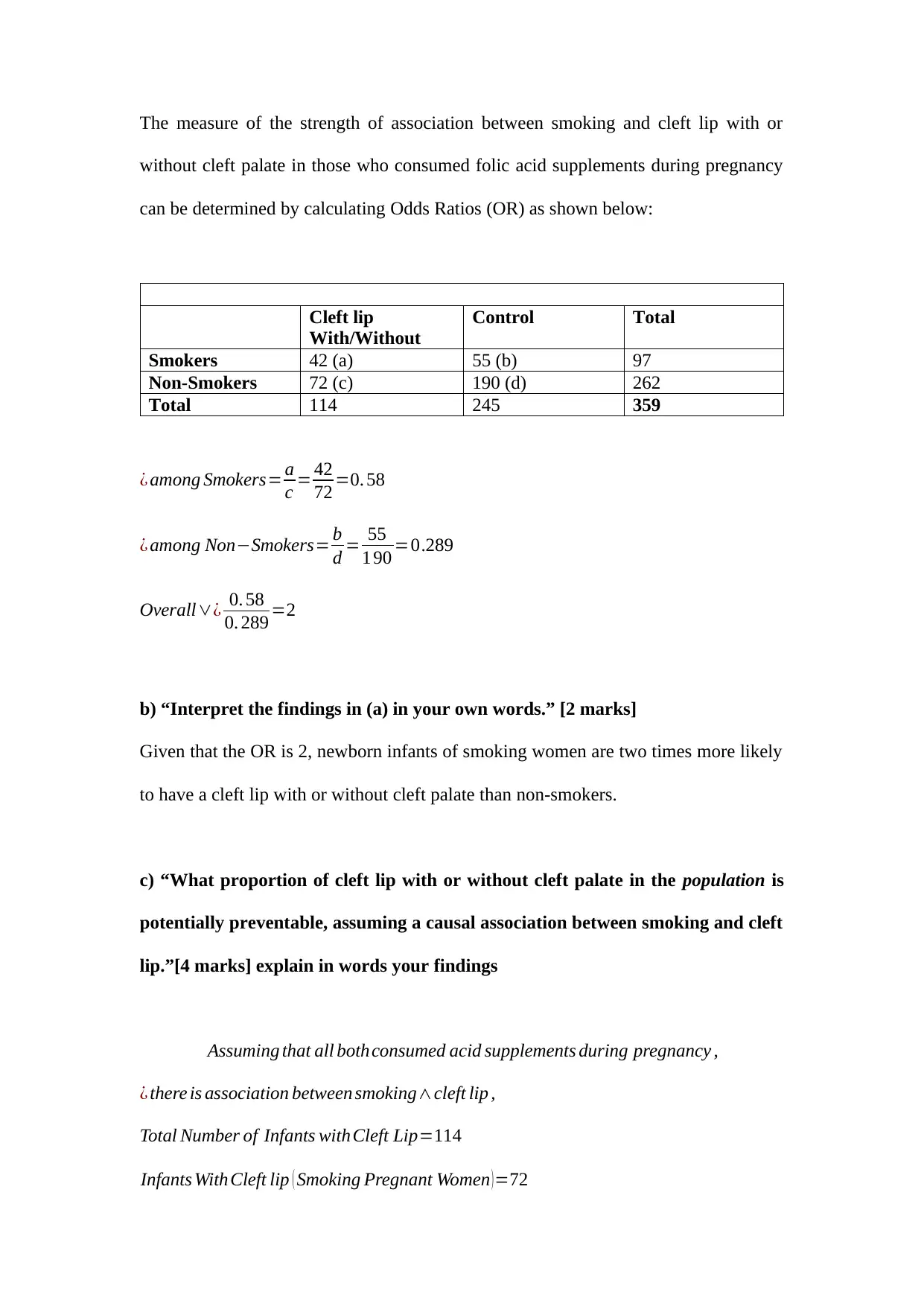
The measure of the strength of association between smoking and cleft lip with or
without cleft palate in those who consumed folic acid supplements during pregnancy
can be determined by calculating Odds Ratios (OR) as shown below:
Cleft lip
With/Without
Control Total
Smokers 42 (a) 55 (b) 97
Non-Smokers 72 (c) 190 (d) 262
Total 114 245 359
¿ among Smokers= a
c = 42
72 =0. 58
¿ among Non−Smokers= b
d = 55
1 90 =0.289
Overall∨¿ 0. 58
0. 289 =2
b) “Interpret the findings in (a) in your own words.” [2 marks]
Given that the OR is 2, newborn infants of smoking women are two times more likely
to have a cleft lip with or without cleft palate than non-smokers.
c) “What proportion of cleft lip with or without cleft palate in the population is
potentially preventable, assuming a causal association between smoking and cleft
lip.”[4 marks] explain in words your findings
Assuming that all both consumed acid supplements during pregnancy ,
¿ there is association between smoking∧cleft lip ,
Total Number of Infants withCleft Lip=114
Infants With Cleft lip ( Smoking Pregnant Women )=72
without cleft palate in those who consumed folic acid supplements during pregnancy
can be determined by calculating Odds Ratios (OR) as shown below:
Cleft lip
With/Without
Control Total
Smokers 42 (a) 55 (b) 97
Non-Smokers 72 (c) 190 (d) 262
Total 114 245 359
¿ among Smokers= a
c = 42
72 =0. 58
¿ among Non−Smokers= b
d = 55
1 90 =0.289
Overall∨¿ 0. 58
0. 289 =2
b) “Interpret the findings in (a) in your own words.” [2 marks]
Given that the OR is 2, newborn infants of smoking women are two times more likely
to have a cleft lip with or without cleft palate than non-smokers.
c) “What proportion of cleft lip with or without cleft palate in the population is
potentially preventable, assuming a causal association between smoking and cleft
lip.”[4 marks] explain in words your findings
Assuming that all both consumed acid supplements during pregnancy ,
¿ there is association between smoking∧cleft lip ,
Total Number of Infants withCleft Lip=114
Infants With Cleft lip ( Smoking Pregnant Women )=72
⊘ This is a preview!⊘
Do you want full access?
Subscribe today to unlock all pages.

Trusted by 1+ million students worldwide
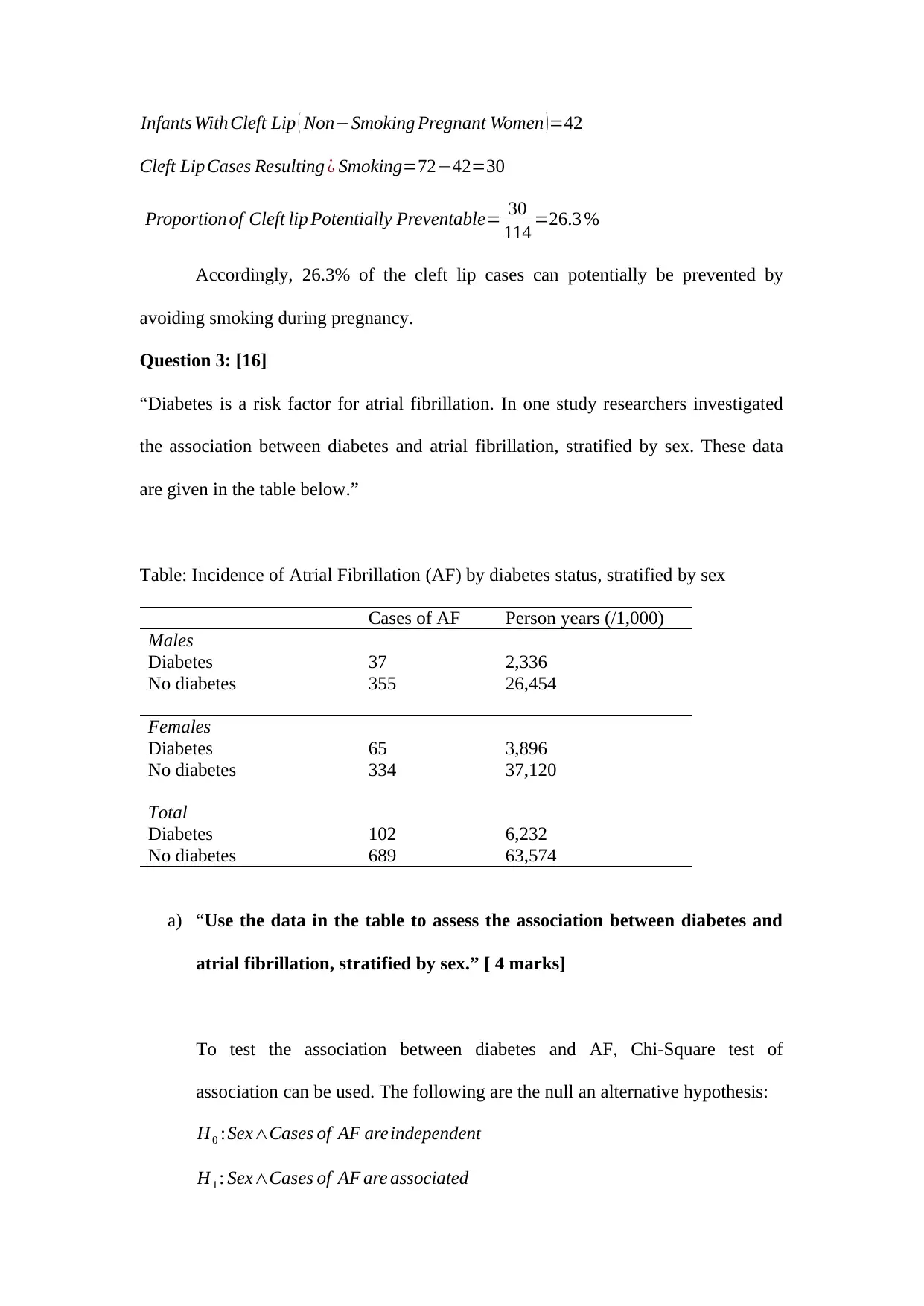
Infants With Cleft Lip ( Non−Smoking Pregnant Women )=42
Cleft Lip Cases Resulting ¿ Smoking=72−42=30
Proportion of Cleft lip Potentially Preventable= 30
114 =26.3 %
Accordingly, 26.3% of the cleft lip cases can potentially be prevented by
avoiding smoking during pregnancy.
Question 3: [16]
“Diabetes is a risk factor for atrial fibrillation. In one study researchers investigated
the association between diabetes and atrial fibrillation, stratified by sex. These data
are given in the table below.”
Table: Incidence of Atrial Fibrillation (AF) by diabetes status, stratified by sex
Cases of AF Person years (/1,000)
Males
Diabetes 37 2,336
No diabetes 355 26,454
Females
Diabetes 65 3,896
No diabetes 334 37,120
Total
Diabetes 102 6,232
No diabetes 689 63,574
a) “Use the data in the table to assess the association between diabetes and
atrial fibrillation, stratified by sex.” [ 4 marks]
To test the association between diabetes and AF, Chi-Square test of
association can be used. The following are the null an alternative hypothesis:
H0 :Sex∧Cases of AF areindependent
H1 : Sex∧Cases of AF are associated
Cleft Lip Cases Resulting ¿ Smoking=72−42=30
Proportion of Cleft lip Potentially Preventable= 30
114 =26.3 %
Accordingly, 26.3% of the cleft lip cases can potentially be prevented by
avoiding smoking during pregnancy.
Question 3: [16]
“Diabetes is a risk factor for atrial fibrillation. In one study researchers investigated
the association between diabetes and atrial fibrillation, stratified by sex. These data
are given in the table below.”
Table: Incidence of Atrial Fibrillation (AF) by diabetes status, stratified by sex
Cases of AF Person years (/1,000)
Males
Diabetes 37 2,336
No diabetes 355 26,454
Females
Diabetes 65 3,896
No diabetes 334 37,120
Total
Diabetes 102 6,232
No diabetes 689 63,574
a) “Use the data in the table to assess the association between diabetes and
atrial fibrillation, stratified by sex.” [ 4 marks]
To test the association between diabetes and AF, Chi-Square test of
association can be used. The following are the null an alternative hypothesis:
H0 :Sex∧Cases of AF areindependent
H1 : Sex∧Cases of AF are associated
Paraphrase This Document
Need a fresh take? Get an instant paraphrase of this document with our AI Paraphraser
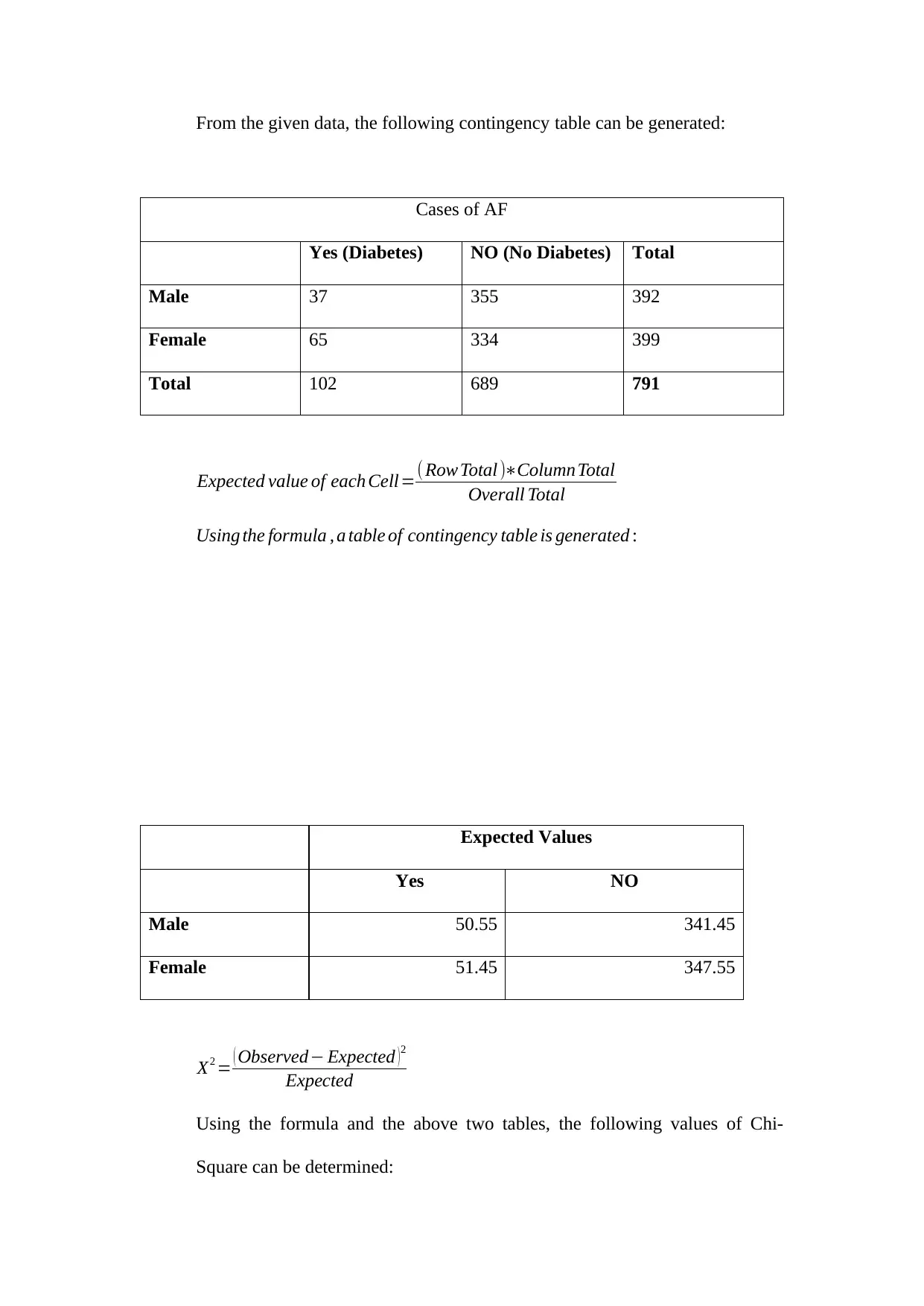
From the given data, the following contingency table can be generated:
Cases of AF
Yes (Diabetes) NO (No Diabetes) Total
Male 37 355 392
Female 65 334 399
Total 102 689 791
Expected value of each Cell=( RowTotal )∗ColumnTotal
Overall Total
Using the formula , a table of contingency table is generated :
Expected Values
Yes NO
Male 50.55 341.45
Female 51.45 347.55
X2 = ( Observed− Expected ) 2
Expected
Using the formula and the above two tables, the following values of Chi-
Square can be determined:
Cases of AF
Yes (Diabetes) NO (No Diabetes) Total
Male 37 355 392
Female 65 334 399
Total 102 689 791
Expected value of each Cell=( RowTotal )∗ColumnTotal
Overall Total
Using the formula , a table of contingency table is generated :
Expected Values
Yes NO
Male 50.55 341.45
Female 51.45 347.55
X2 = ( Observed− Expected ) 2
Expected
Using the formula and the above two tables, the following values of Chi-
Square can be determined:
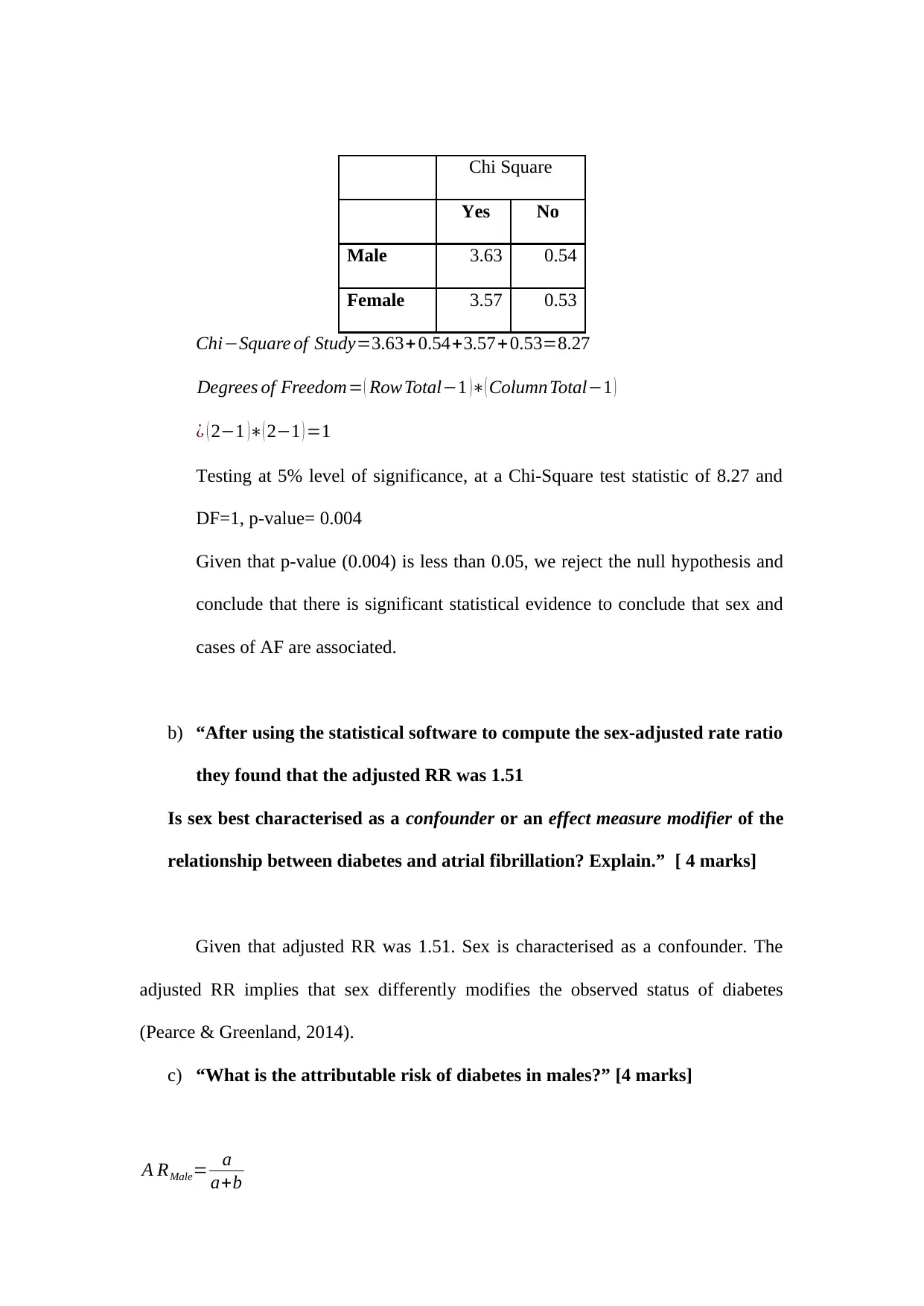
Chi Square
Yes No
Male 3.63 0.54
Female 3.57 0.53
Chi−Square of Study=3.63+ 0.54+3.57+0.53=8.27
Degrees of Freedom= ( RowTotal−1 )∗( ColumnTotal−1 )
¿ ( 2−1 )∗( 2−1 ) =1
Testing at 5% level of significance, at a Chi-Square test statistic of 8.27 and
DF=1, p-value= 0.004
Given that p-value (0.004) is less than 0.05, we reject the null hypothesis and
conclude that there is significant statistical evidence to conclude that sex and
cases of AF are associated.
b) “After using the statistical software to compute the sex-adjusted rate ratio
they found that the adjusted RR was 1.51
Is sex best characterised as a confounder or an effect measure modifier of the
relationship between diabetes and atrial fibrillation? Explain.” [ 4 marks]
Given that adjusted RR was 1.51. Sex is characterised as a confounder. The
adjusted RR implies that sex differently modifies the observed status of diabetes
(Pearce & Greenland, 2014).
c) “What is the attributable risk of diabetes in males?” [4 marks]
A RMale= a
a+b
Yes No
Male 3.63 0.54
Female 3.57 0.53
Chi−Square of Study=3.63+ 0.54+3.57+0.53=8.27
Degrees of Freedom= ( RowTotal−1 )∗( ColumnTotal−1 )
¿ ( 2−1 )∗( 2−1 ) =1
Testing at 5% level of significance, at a Chi-Square test statistic of 8.27 and
DF=1, p-value= 0.004
Given that p-value (0.004) is less than 0.05, we reject the null hypothesis and
conclude that there is significant statistical evidence to conclude that sex and
cases of AF are associated.
b) “After using the statistical software to compute the sex-adjusted rate ratio
they found that the adjusted RR was 1.51
Is sex best characterised as a confounder or an effect measure modifier of the
relationship between diabetes and atrial fibrillation? Explain.” [ 4 marks]
Given that adjusted RR was 1.51. Sex is characterised as a confounder. The
adjusted RR implies that sex differently modifies the observed status of diabetes
(Pearce & Greenland, 2014).
c) “What is the attributable risk of diabetes in males?” [4 marks]
A RMale= a
a+b
⊘ This is a preview!⊘
Do you want full access?
Subscribe today to unlock all pages.

Trusted by 1+ million students worldwide
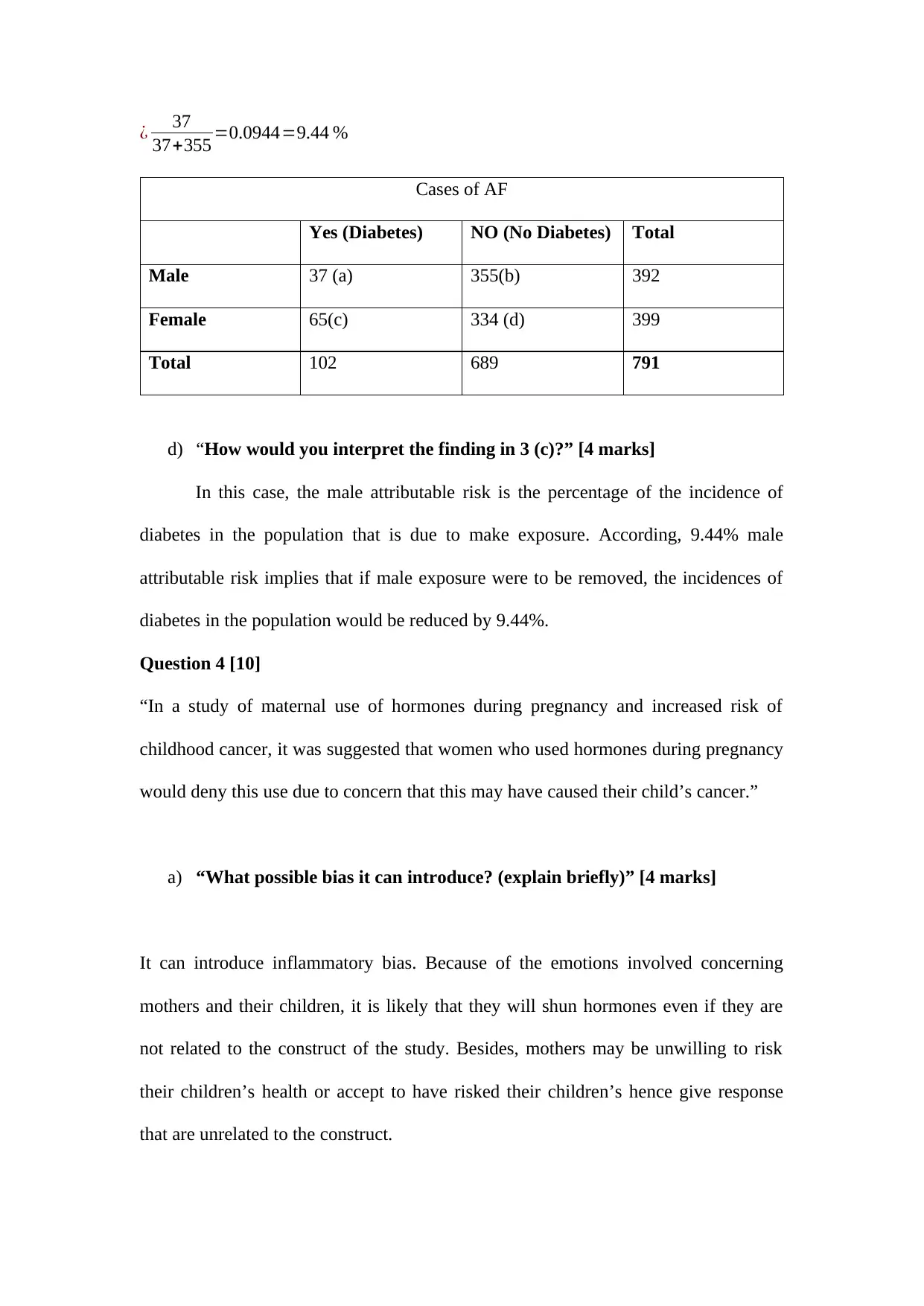
¿ 37
37+355 =0.0944=9.44 %
Cases of AF
Yes (Diabetes) NO (No Diabetes) Total
Male 37 (a) 355(b) 392
Female 65(c) 334 (d) 399
Total 102 689 791
d) “How would you interpret the finding in 3 (c)?” [4 marks]
In this case, the male attributable risk is the percentage of the incidence of
diabetes in the population that is due to make exposure. According, 9.44% male
attributable risk implies that if male exposure were to be removed, the incidences of
diabetes in the population would be reduced by 9.44%.
Question 4 [10]
“In a study of maternal use of hormones during pregnancy and increased risk of
childhood cancer, it was suggested that women who used hormones during pregnancy
would deny this use due to concern that this may have caused their child’s cancer.”
a) “What possible bias it can introduce? (explain briefly)” [4 marks]
It can introduce inflammatory bias. Because of the emotions involved concerning
mothers and their children, it is likely that they will shun hormones even if they are
not related to the construct of the study. Besides, mothers may be unwilling to risk
their children’s health or accept to have risked their children’s hence give response
that are unrelated to the construct.
37+355 =0.0944=9.44 %
Cases of AF
Yes (Diabetes) NO (No Diabetes) Total
Male 37 (a) 355(b) 392
Female 65(c) 334 (d) 399
Total 102 689 791
d) “How would you interpret the finding in 3 (c)?” [4 marks]
In this case, the male attributable risk is the percentage of the incidence of
diabetes in the population that is due to make exposure. According, 9.44% male
attributable risk implies that if male exposure were to be removed, the incidences of
diabetes in the population would be reduced by 9.44%.
Question 4 [10]
“In a study of maternal use of hormones during pregnancy and increased risk of
childhood cancer, it was suggested that women who used hormones during pregnancy
would deny this use due to concern that this may have caused their child’s cancer.”
a) “What possible bias it can introduce? (explain briefly)” [4 marks]
It can introduce inflammatory bias. Because of the emotions involved concerning
mothers and their children, it is likely that they will shun hormones even if they are
not related to the construct of the study. Besides, mothers may be unwilling to risk
their children’s health or accept to have risked their children’s hence give response
that are unrelated to the construct.
Paraphrase This Document
Need a fresh take? Get an instant paraphrase of this document with our AI Paraphraser
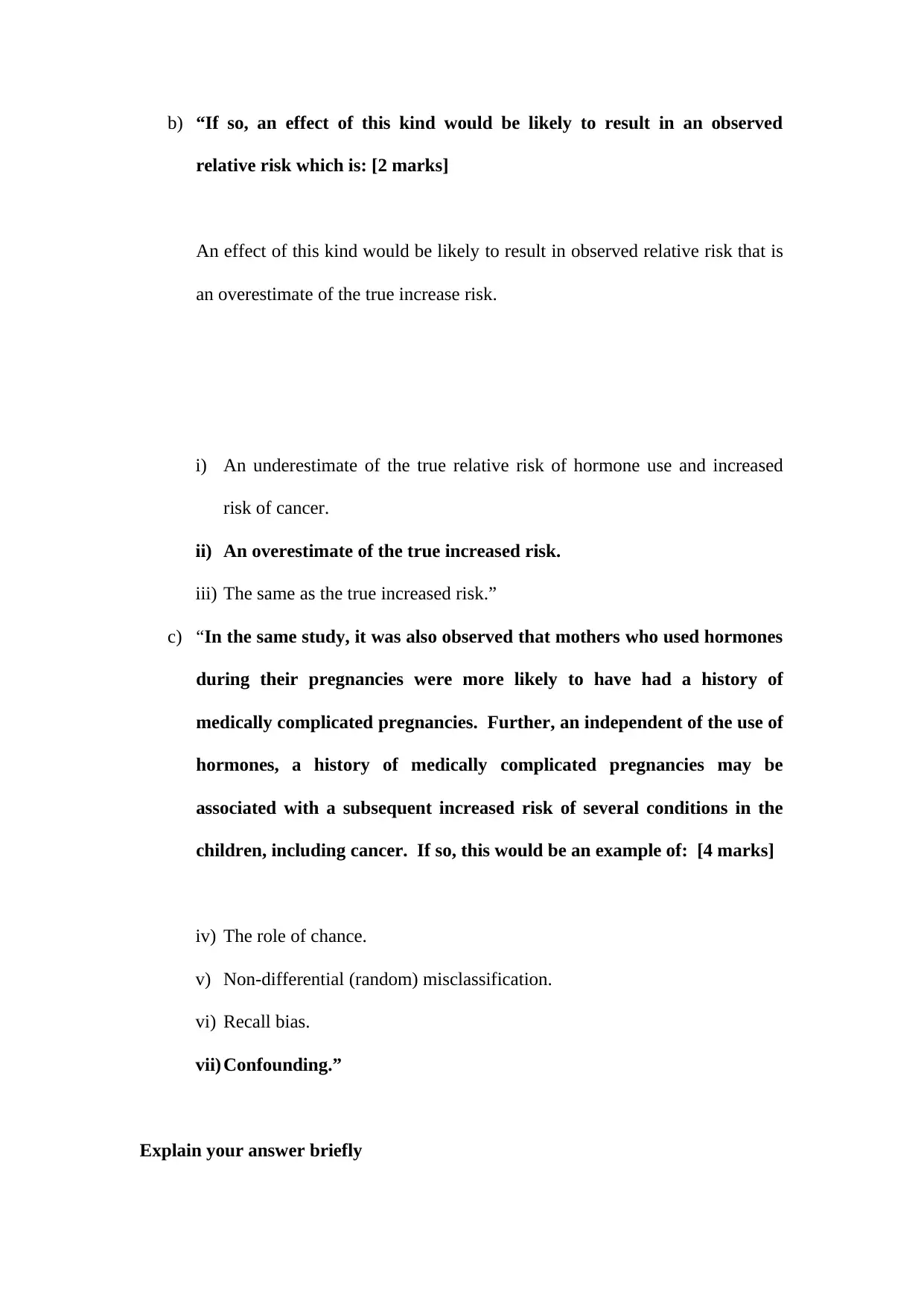
b) “If so, an effect of this kind would be likely to result in an observed
relative risk which is: [2 marks]
An effect of this kind would be likely to result in observed relative risk that is
an overestimate of the true increase risk.
i) An underestimate of the true relative risk of hormone use and increased
risk of cancer.
ii) An overestimate of the true increased risk.
iii) The same as the true increased risk.”
c) “In the same study, it was also observed that mothers who used hormones
during their pregnancies were more likely to have had a history of
medically complicated pregnancies. Further, an independent of the use of
hormones, a history of medically complicated pregnancies may be
associated with a subsequent increased risk of several conditions in the
children, including cancer. If so, this would be an example of: [4 marks]
iv) The role of chance.
v) Non-differential (random) misclassification.
vi) Recall bias.
vii) Confounding.”
Explain your answer briefly
relative risk which is: [2 marks]
An effect of this kind would be likely to result in observed relative risk that is
an overestimate of the true increase risk.
i) An underestimate of the true relative risk of hormone use and increased
risk of cancer.
ii) An overestimate of the true increased risk.
iii) The same as the true increased risk.”
c) “In the same study, it was also observed that mothers who used hormones
during their pregnancies were more likely to have had a history of
medically complicated pregnancies. Further, an independent of the use of
hormones, a history of medically complicated pregnancies may be
associated with a subsequent increased risk of several conditions in the
children, including cancer. If so, this would be an example of: [4 marks]
iv) The role of chance.
v) Non-differential (random) misclassification.
vi) Recall bias.
vii) Confounding.”
Explain your answer briefly
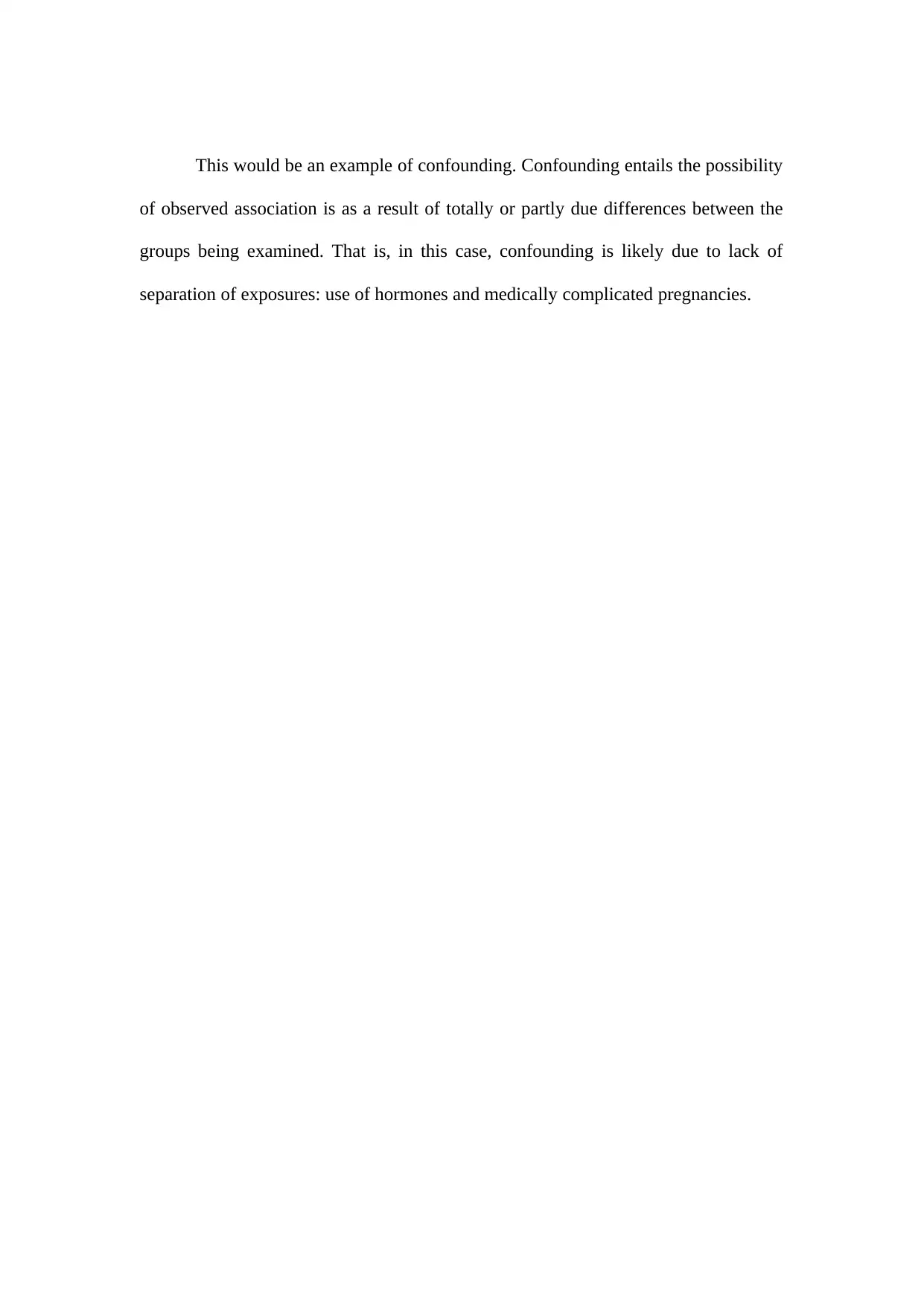
This would be an example of confounding. Confounding entails the possibility
of observed association is as a result of totally or partly due differences between the
groups being examined. That is, in this case, confounding is likely due to lack of
separation of exposures: use of hormones and medically complicated pregnancies.
of observed association is as a result of totally or partly due differences between the
groups being examined. That is, in this case, confounding is likely due to lack of
separation of exposures: use of hormones and medically complicated pregnancies.
⊘ This is a preview!⊘
Do you want full access?
Subscribe today to unlock all pages.

Trusted by 1+ million students worldwide
1 out of 13
Related Documents
Your All-in-One AI-Powered Toolkit for Academic Success.
+13062052269
info@desklib.com
Available 24*7 on WhatsApp / Email
![[object Object]](/_next/static/media/star-bottom.7253800d.svg)
Unlock your academic potential
Copyright © 2020–2025 A2Z Services. All Rights Reserved. Developed and managed by ZUCOL.





